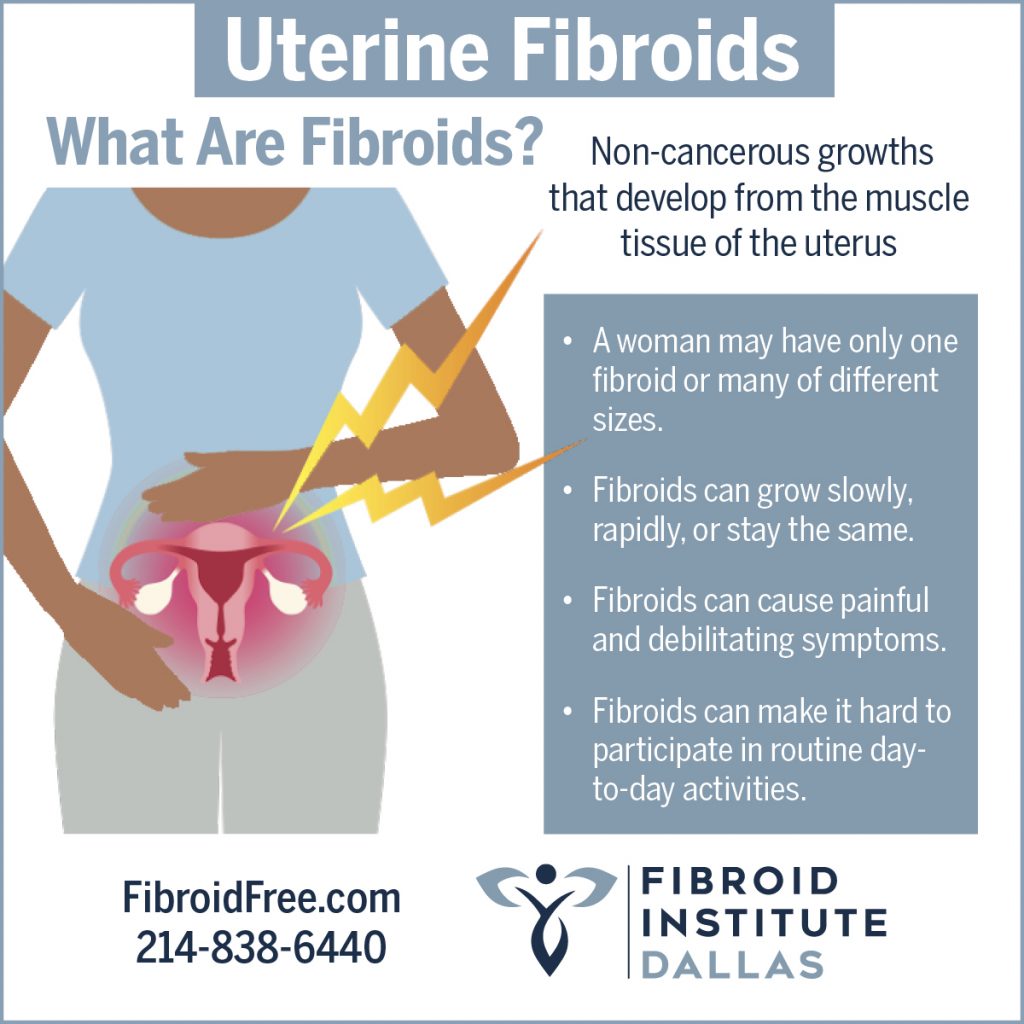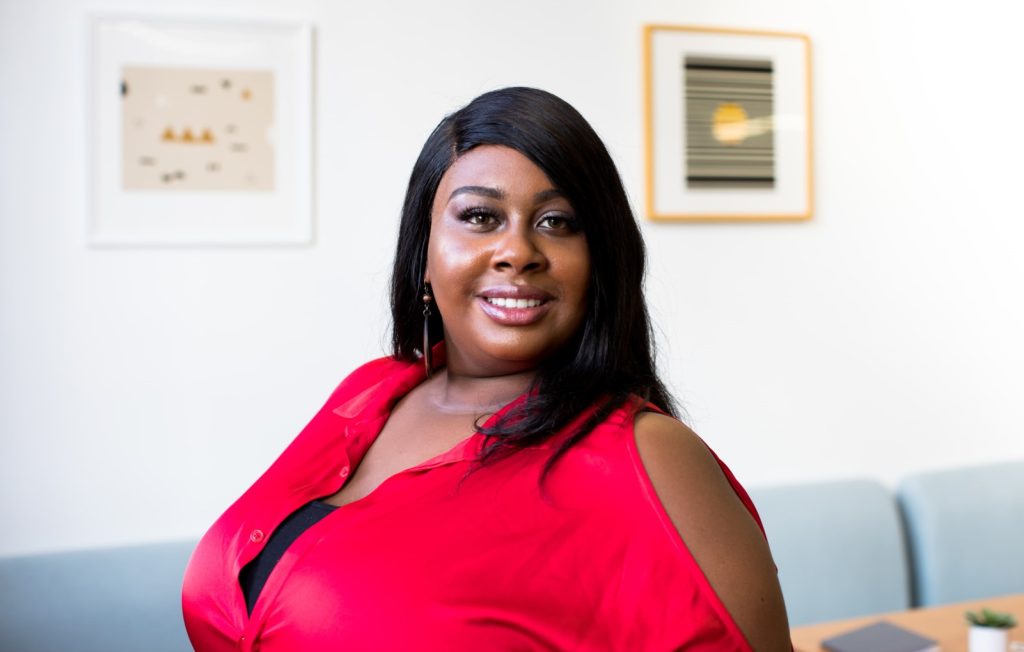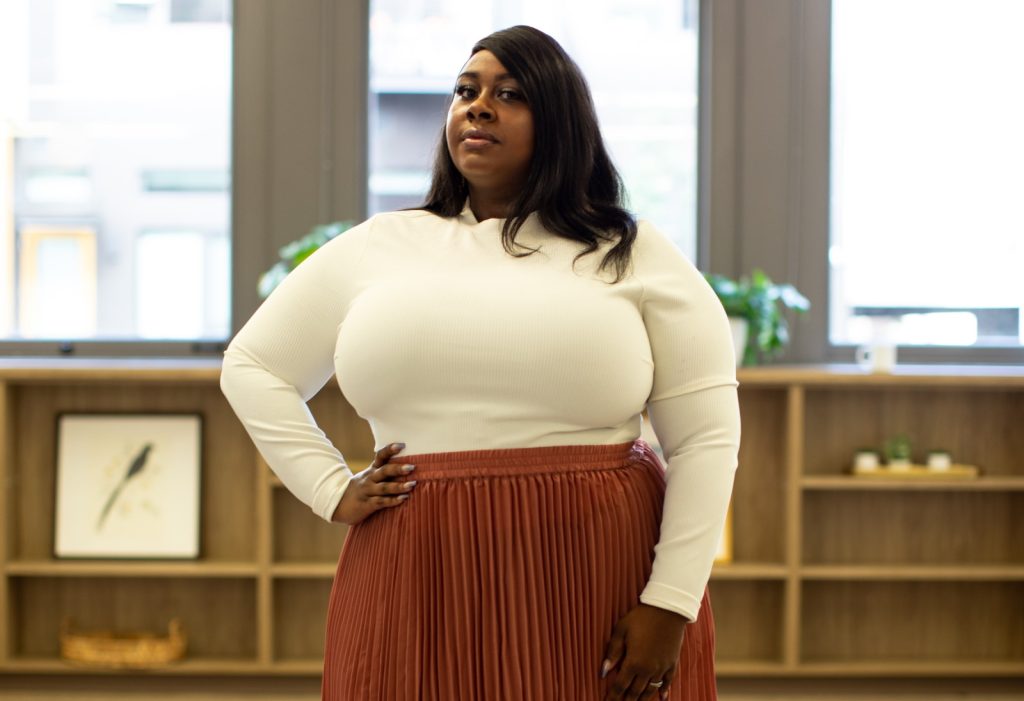At 40 years old, Shawnda* was tired of having heavy periods every two weeks. Other fibroid symptoms she experienced included:
- severe pain in her abdomen and back
- cramping and bloating
- constipation and urinary frequency
Shawnda felt like she was missing out on many of life’s adventures due to her uterine fibroids. She was ready to find treatment, preferably one that did not involve surgery. When she heard about Fibroid Institute Dallas and Uterine Fibroid Embolization (UFE), she was excited to schedule a consultation to find out if she was a good candidate for the procedure.
What Are Uterine Fibroids?
In her consultation, Shawnda learned that fibroids are tumors made of smooth muscle cells and fibrous connective tissue. They develop in the uterus, tend to grow, and can also increase in quantity. That is one reason why getting fibroid treatment is so important.
Shawnda also learned that an estimated 70-80% of all women develop uterine fibroids between the ages of 35 and 54. They also can occur in women younger than 35 and until menopause. Many women do not realize that they have fibroids as they are not experiencing negative fibroid symptoms, but rather find out about them during tests for other conditions. Fibroids are usually benign but may cause life-interrupting symptoms such as Shawnda’s heavy periods.

Common fibroid symptoms include:
- Pelvic pain or pressure
- Heavy periods, which can be heavy enough to cause anemia
- Irregular menstruation and/or periods that last longer than a week
- Constipation
- Urinary frequency
- Painful sex
- Pain radiating to the lower back, hip, buttock, thigh, or down the leg
- Bloating and swelling
- Difficulty lying face down, bending over or exercising without discomfort
- Weight gain in the abdomen, giving an appearance of normal belly fat
The Risk of Fibroids for Black Women
Black women have a higher risk of developing uterine fibroids and they develop fibroids at a younger age than other women. According to the Black Women’s Health Imperative, the rate of hospitalization for fibroids is three times higher for Black women than white women. They are also two to three times more likely to undergo a hysterectomy and seven times more likely to have a myomectomy. In these surgeries, complications and blood transfusions are more common than in White women.
Since Black women historically suffer greater complications during fibroid removal surgery, finding alternative treatments is beneficial to reducing risks. In her consultation, Shawnda discovered that UFE is a great option for women experiencing moderate to severe fibroid symptoms.
What Is Uterine Fibroid Embolization (UFE)?
UFE is a revolutionary fibroid treatment that uses image-guided interventional radiology. A small catheter is placed in the patient’s wrist, where tiny particles are introduced through the uterine arteries to block blood flow to the fibroids, therefore causing them to shrink and die. With this minimally invasive procedure, there are less risks and a quicker recovery time than fibroid surgery, all while reducing your fibroid symptoms.
Advantages of UFE include:
- Procedure typically takes less than an hour
- Tiny wrist puncture, no need for vaginal access
- No blood loss
- All fibroids may be treated at the same time
- Recovery time only 7-10 days versus 4-6 weeks for surgery
- No abdominal (belly) incision
- Over 90% effective
- Covered by most insurances
Shawnda was tired of living with heavy periods and her other fibroid symptoms. After a thorough review of her options, Shawnda decided on the UFE procedure at Fibroid Institute Dallas. She appreciated the education she received about fibroid treatments and understanding the benefits of each one. She felt comfortable with and cared for by the entire staff. She even got the doctor’s personal mobile phone number to call with any questions and concerns after the procedure!

No More Heavy Periods
Fast forward one month after her UFE procedure and Shawnda feels great. Her fibroid symptoms are close to gone! She no longer suffers from cramping, bloating, and heavy periods. She hasn’t even had the need to take laxatives. Plus, over time her fibroids will continue to shrink, and she will experience fewer and fewer symptoms.
According to Shawnda, “I can go outside when my son comes home! I feel normal again, which I hadn’t felt for years.” She admits to crying tears of joy when she had her first cycle after the procedure as it was her first “normal” cycle in a long time. To anyone needing treatment for their fibroid symptoms including heavy periods, she highly recommends UFE. “Absolutely do it. I should have done it years ago. It changed my life!”
“UFE Changed My Life!”
You can change your life, too. Get fibroid free with an easy 3-step process.
Fibroid Free in 1-2-3

Schedule Your Consultation for Fibroid Treatment
Do you have fibroid symptoms like Shawnda? Are you interested in learning more about UFE for fibroid treatment? Educate yourself about non-surgical fibroid treatment at Fibroid Institute Dallas.
The expert doctors and specialized team at Fibroid Institute Dallas have helped thousands of women discover the joys of living fibroid free. With each UFE procedure, patients are empowered to achieve their full potential without being limited by fibroid symptoms. For Shawnda and many others, the UFE procedure changed their lives.
You will need a formal consultation to determine if you are a candidate before scheduling your procedure. Call for a telehealth consult or an in-office appointment at 214-838-6440 or complete the form below.
"*" indicates required fields
*names and/or photos may be changed to protect patient confidentiality
Every patient’s fibroid journey is different. Scheduling a medical consultation to discuss your symptoms will provide you with information specific to your treatment options. This article is not a substitute for professional medical advice.
Fibroid Institute Dallas serves the DFW area including Garland, Mesquite, Richardson, Addison, Carrollton, Plano, Frisco, McKinney, Allen, Dallas, Duncanville, DeSoto, Cedar Hill, Lancaster, Cockrell Hill, Highland Park, University Park, Park Cities, Grand Prairie, Arlington, HEB, Fort Worth, Hutchins, Irving, and all of North Texas.

